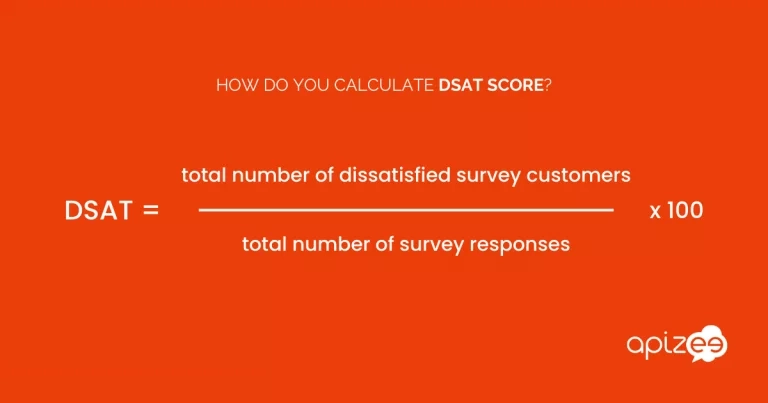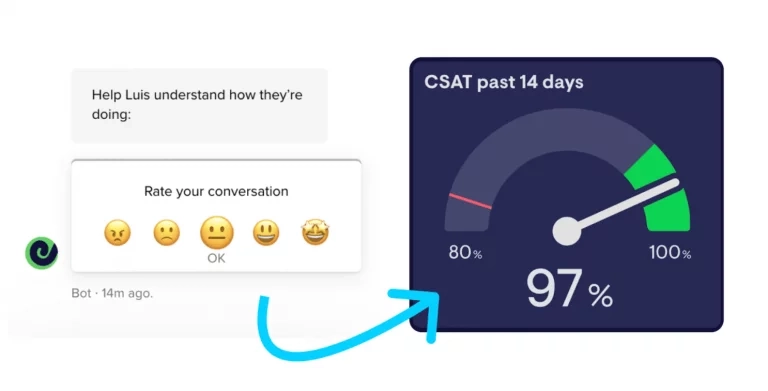Understanding DSAT: A Key Metric
for Measuring Contact Center
Customer Dissatisfaction



Maintaining high levels of customer satisfaction is critical to the success of any contact center. But how do you measure and track customer satisfaction effectively?
Enter DSAT, a key metric that helps contact centers understand how satisfied their customers are with their experience. In this article, we’ll explore the ins and outs of DSAT, from what it is and how to measure it, to strategies for reducing it and making it a priority in your contact center.
Curious to learn more about the world of DSAT and its crucial role in measuring and improving customer satisfaction in your contact center? Keep reading as we dive into this essential metric and explore strategies for optimizing your DSAT score.
DSAT, or customer dissatisfaction, is a critical metric for measuring how satisfied your customers are with their experience in your contact center. DSAT is calculated as the percentage of customers who report being dissatisfied with their experience, either during a specific interaction or over a longer period of time. This metric is often used in conjunction with other customer satisfaction metrics, such as CSAT and NPS, to provide a more complete picture of customer experience and help contact centers identify areas for improvement.
Measuring DSAT involves analyzing the responses to the same question that asks about customer satisfaction (like CSAT). This can be achieved through various methods, such as gathering customer feedback through surveys and monitoring interactions via quality assurance programs. The threshold for a “high” DSAT score may vary by industry and customer base, but generally, a high DSAT score suggests that something is not quite right with your contact center operations and customer experience.
It’s worth noting that DSAT is not just an indicator of customer dissatisfaction, but also a predictor of future behavior. Addressing any issues that may be contributing to high DSAT scores is crucial for contact centers, as customers who report high levels of dissatisfaction are more likely to leave and take their business elsewhere. In fact, studies have shown that after more than one bad experience, around 80% of consumers say they would rather do business with a competitor.
Here are four reasons why DSAT is a critical metric to track for any business:
DSAT is a direct indicator of how satisfied or dissatisfied customers are with their experience in your contact center. By tracking DSAT, you can gain insight into customer sentiment and identify areas for improvement in your operations.
High DSAT scores can indicate specific problems or pain points that customers are experiencing in your contact center. By identifying and addressing these areas, you can improve the overall customer experience and reduce customer churn.
As mentioned earlier, customers who report high levels of dissatisfaction are more likely to leave and take their business elsewhere. By tracking DSAT over time, you can identify trends and patterns in customer behavior and take proactive steps to retain customers.
DSAT is a key driver for continuous improvement in your contact center. By tracking and monitoring this metric, you can identify areas for improvement, set goals for improvement, and measure progress over time. This helps ensure that your contact center is always striving to provide the best possible customer experience.
In the next section, we’ll explore how to measure and track DSAT effectively to improve your contact center’s customer satisfaction.
Calculating your DSAT score is a straightforward process that involves gathering feedback from your customers about their experience with your contact center.
The formula for calculating DSAT is:
DSAT = (Number of Dissatisfied Customers / Total Number of Customers Surveyed) x 100%
For example, if you surveyed 100 customers and 20 of them reported being dissatisfied with their experience, your DSAT score would be:
DSAT = (20 / 100) x 100% = 20%

To get an accurate and representative view of customer satisfaction, it’s important to gather feedback from a significant number of customers over an appropriate time period. This could involve conducting regular surveys, gathering feedback after each interaction, or reviewing quality assurance data.
While DSAT is a valuable metric for measuring contact center performance, it’s important to remember that it’s just one of many metrics that can be used to gauge customer satisfaction. When evaluating your contact center’s performance, it’s important to consider multiple metrics, such as CSAT, NPS, and FCR, to get a more comprehensive view of the customer experience.
DSAT and CSAT (Customer Satisfaction) are both important metrics for measuring customer experience, but they differ in several ways.
When it comes to measuring customer satisfaction, CSAT data is one of the most popular KPIs. However, it’s important not to overlook customer dissatisfaction (DSAT) data when evaluating customer satisfaction levels. DSAT is derived from CSAT survey responses and represents the percentage of customers who are dissatisfied with their contact center experience. Brands typically send CSAT surveys after customer service interactions, asking customers to rate their satisfaction on a scale of 1-5. Responses labeled as 1 or 2 fall into the DSAT category.

Source: Geckoboard
To gain a deeper understanding of the reasons behind customer dissatisfaction, it’s helpful to include a free-form text box below your CSAT survey where customers can explain why they gave the score they did. This is crucial for a DSAT analysis, as it allows you to identify specific pain points and address them directly. Additionally, calculating and analyzing CSAT data can be helpful in identifying areas for improvement and ultimately reducing your DSAT score.
By gathering feedback from customers about specific interactions, you can pinpoint where issues are occurring and take steps to address them. Analyzing trends in your CSAT and DSAT scores over time can also help you track progress and evaluate the effectiveness of your customer service strategies.
In the next section, we’ll discuss strategies for reducing DSAT and improving customer satisfaction in your contact center.
While tracking DSAT is important, it’s equally important to take action to reduce it. Identifying and addressing the root causes of customer dissatisfaction can help improve the overall customer experience and drive customer loyalty.
In this section, we’ll explore some strategies for reducing DSAT, including identifying common causes of DSAT and addressing them, investing in employee training and performance management, and leveraging technology to improve contact center operations and customer satisfaction.
To reduce DSAT, it’s important to identify the root causes of customer dissatisfaction. Common causes of DSAT can include long wait times, ineffective communication, lack of personalization, unhelpful agents, and technical issues.
Conducting customer surveys, monitoring calls and chats, and analyzing customer feedback can help you identify common pain points and take steps to address them. By making changes to your processes, procedures, and training programs, you can improve the overall customer experience and reduce DSAT.
Well-trained agents who understand how to handle difficult customer interactions can be key to reducing DSAT. To ensure your agents are providing quality customer service, invest in ongoing training and performance management.
This can include regular coaching sessions, customer service workshops, and online training modules. Providing agents with the tools and resources they need to succeed can help improve the quality of their interactions and ultimately reduce DSAT.
Technology can play a significant role in reducing DSAT and improving overall contact center operations. By leveraging tools such as chatbots, automated email responses, remote video support and AI-powered analytics, you can streamline your operations and provide faster, more personalized service to your customers.
Implementing a comprehensive CRM system can also help you track customer interactions and identify areas for improvement. By utilizing technology to improve your operations, you can enhance the overall customer experience and reduce DSAT.
DSAT is an often-overlooked metric that can provide valuable insight into customer satisfaction levels. By tracking DSAT and implementing strategies to reduce it, businesses can improve their customer experience and drive loyalty.
In this article, we’ve explored what DSAT is, why it’s important, and how to calculate it. We’ve also looked at the differences between DSAT and CSAT and how the two metrics can work together to improve customer satisfaction. Finally, we’ve discussed strategies for reducing DSAT, including identifying common causes of DSAT, investing in employee training and performance management, and leveraging technology.
As customer expectations continue to rise, it’s critical for businesses to prioritize customer satisfaction. By paying attention to DSAT and taking steps to reduce it, businesses can build stronger relationships with their customers and drive long-term success.
Looking to delight more customers? Discover Apizee today to create more human customer service moments.
Claire Boscq, CX Activator and founder of JCX Alliance, shares her unique approach to wellbeing-led customer experience. Discover her vision in this new Apizee CX Voices interview.
[CX Industry Voices] Interview with Claire Boscq
25 Jun 2025
Call Centre Helper’s Xander Freeman spoke to Charles Kergaravat, CMO at Apizee, about the rise of video chat in customer service.
The rise of Video Chat in customer service
20 Jun 2025
Simon Macklin from Salesforce, explains how AI and human empathy combine to shape the future of CX. Discover insights in the latest Apizee CX Voices interview.
[CX Industry Voices] Interview with Simon Macklin
19 Jun 2025
Interested in our solutions?